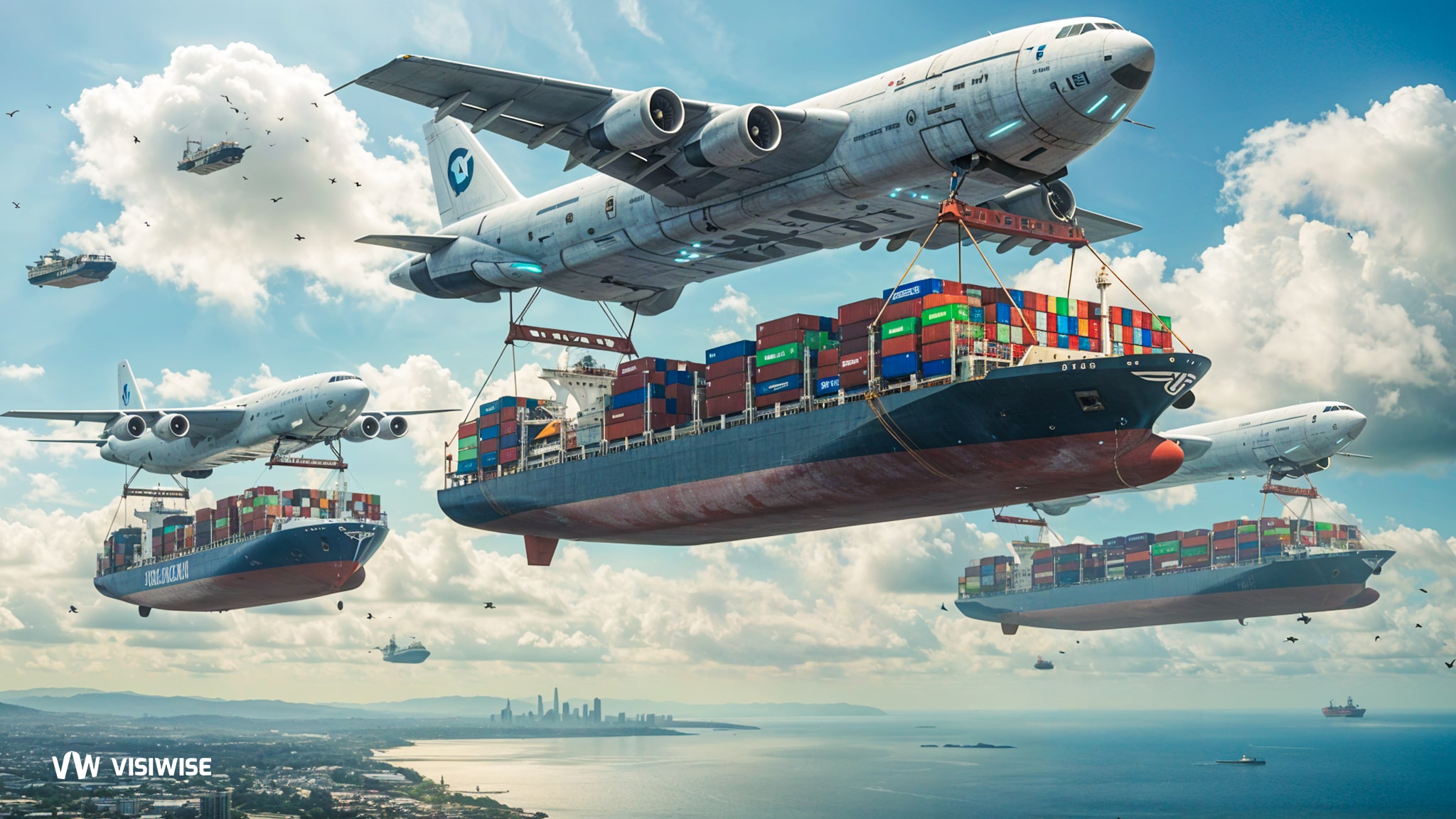Ever needed something yesterday? Whether it’s a shipment of life-saving vaccines, a last-minute prototype for a big pitch, or that one critical part keeping a factory running—some things just can’t wait for a slow boat.
That’s where air freight forwarders play a main role. They’re the behind-the-scenes maestros making sure your urgent cargo doesn’t just get there, but gets there fast, smoothly, and without you having to sweat the details.
So in this guide, we’re about to break down how air freight forwarding really works.
What Air Freight Forwarding Really Means
Air freight forwarding is all about managing the transport and logistics of air cargo—from one part of the world to another—using cargo planes or even regular passenger aircraft. While it might sound simple, importing cargo by air often turns out to be more complex than expected.
There’s a lot to consider: which airline suits your cargo, which one offers the right facilities, and who gives the best rate. This is where air freight forwarders become your secret weapon. They link everything and everyone : you as the shipper , the airlines, customs officials, trucking companies, and everyone else in the supply chain. Without an expert in your corner, you’d be stuck playing a never-ending game of phone tag with carriers, drowning in paperwork, and constantly putting out fires.
Why Work with an Air Freight Forwarder?
Teaming up with a freight forwarding expert brings a lot of advantages:
- You get full access to real-time tracking at every step.
- They handle compliance and regulations for your cargo.
- Any hiccups during air transport? They sort it out.
- They guide you through the maze of international air freight rules.
- They help secure competitive air freight rates and choose the right airline.
- All documents for import and export are prepared accurately and submitted correctly.
- They help you find the best shipping options and plan your shipment properly.
- You also get advice on shipment weight, size, and choosing the most efficient air freight setup.
With Ship4wd’s air freight service, your cargo is in good hands. We ensure fast, reliable, and secure air freight forwarding—so your shipments arrive on time and you can focus on growing your business. It’s a hassle-free solution for SMBs and eCommerce owners who need things to just work.
Pros and Cons
| Pros | Cons |
| Fast delivery over long distances | High shipping costs |
| Reliable schedules with frequent flights | Limited cargo size and weight |
| High security and tight cargo handling | Greater environmental impact |
| Global access, including remote locations | Susceptible to weather-related delays |
| Real-time tracking and shipment visibility | Requires complex documentation |
| Lower risk of damage due to short transit time | Not suitable for bulky or oversized shipments |
All the Documents Required for International Air Freight
Like with all methods of international shipping, air freight involves a fair amount of documentation. Here we will explain many of the documents needed for your cargo to have a smooth journey from start to finish.
Documents You Must Have:
Commercial Invoice
It includes the description of goods, prices, quantities, harmonized system (HS) codes, country of origin, and the specifics about both the seller and the buyer.
Packing List
It gives extra cargo info: dimensions, weight, contents. Helps handlers work faster and safer. Include the commercial invoice number.
Airway Bill (AWB)
The Airway Bill is another necessity. It’s basically the air freight version of a Bill of Lading. Air waybill (AWB) is a document that accompanies goods shipped by an international air courier to provide detailed information about the shipment and allow it to be tracked. The bill has multiple copies so that each party involved in the shipment can document it.
Sometimes Needed:
Certificate of Origin (CO)
Proves where goods were made. Often needed for customs and trade agreement benefits.
Declaration for Dangerous Goods
For hazardous items. Confirms proper packing and labeling under DGRs and required license.
MSDS
Needed for hazardous chemicals. Lists handling instructions to protect loaders.
And More…
Other possible documents:
- Handling receipts
- Insurance
- SAD / C88
- Letter of indemnity
Two Key Air Freight Options: DAWB vs. MAWB
When You Ship with a Direct Airway Bill (DAWB)
A direct airway bill, or DAWB, is used when your freight goes straight on the airline without a house airway bill (HAWB). This method is often chosen when things need to move fast. Since your shipment isn’t grouped with others, it won’t need deconsolidation. You can simply collect your goods directly from the Cargo Terminal Operator (CTO).
When You Ship with a Master Airway Bill (MAWB)
A master airway bill (MAWB) covers shipments that include one or more house airway bills (HAWBs)—these are issued by a freight handler acting as the carrier. If you use a MAWB, your shipment is probably consolidated, meaning it’s grouped together with other shipments.
Once it lands, the cargo goes to a Customs Bond facility to be deconsolidated. That’s where everything gets unpacked and sorted based on each shipment’s final destination. Customs is notified of the arrival through an outturn report, which lists the details of the cargo unloaded in Australia. Every shipment must have an outturn report.
In Summary:
Go with DAWB if:
- Speed is critical
- Your shipment isn’t part of a group load
- You want faster pickup at the destination
Choose MAWB if:
- You’re shipping in bulk
- You’re okay with a bit of extra handling time
- You want cost savings for consolidated freight
Process of Air Freight Forwarding in a Nutshell
Though it appears simple, the process can turn complicated. Businesses have to ascertain if air freight fits best, guarantee correct documentation, and work with a freight forwarder to smoothly handle the process.
Step 1: Requesting Quotes and Ordering Products
Choosing suppliers able to meet air freight specifications marks the beginning of the procedure. Buyers need to study vendors, negotiate Incoterms, employ a freight forwarder, and submit commercial papers. To avoid delays, freight forwarders frequently manage supplier communication and documentation.
Step 2: Understanding Air Freight Impacts
Importers should know how air freight works before confirming the delivery. Important factors are container kinds—ULDs or loose cargo—volumetric weight fees, and compliance with air freight security requirements. Cargo might need to be x-rayed and loaded on acceptable pallets.
Step 3: Packing and Booking Freight
Once ready, cargo has to be booked and correctly packed. Shippers should verify aircraft restrictions, weigh services, and select the most appropriate route depending on travel time and price.
Step 4: Freight Forwarder Arranges Shipment
The freight forwarder organizes the shipping once it is reserved. Commercial invoices, packing lists, certificates of origin, import permits, and dangerous goods forms are among the required documents. Typically traceable online, shipments can also be given an airway invoice upon booking of the aircraft.
Step 5: Export Clearance and Transit
Customs clearance starts when freight begins moving through transit. Once the shipment arrives, the Cargo Terminal Operator (CTO) takes charge of it, secures the cargo, and gets it ready for pickup.
Step 6: Delivery to Buyer
Cargo is sent to the customer once cleared and outturned. Confirm if unloading equipment such as a tail lift is necessary and check delivery times. The freight forwarder organizes these specifications to guarantee prompt delivery.
Air Cargo Tracking
To track your air cargo, visit the airline website’s track shipments section and input your Airway Bill (AWB) number to get details of the cargo’s air route, a tracking report, status update, and estimated time of arrival for your shipment.
An AWB is a document issued by the airline and serves as evidence of the contract for the shipment. It contains details about the goods being transported. It has a unique 11-digit number that helps the shipping company keep track of cargo movements and serves as a way to identify your consignment.
FAQs
Q: What exactly are the steps in freight forwarding?
A: It’s like a relay race for your shipment:
- You get quotes and book space (shopping around for the best deal),
- Pack everything bulletproof (because airlines aren’t gentle),
- Drown in paperwork (customs forms, invoices, permits—the fun stuff),
- Ship it out (wave goodbye to your cargo),
- Clear customs (where your paperwork gets its moment to shine),
- Final delivery (and breathe a sigh of relief).
Q: How does air freight actually work?
A: Imagine your package taking a business trip:
- First, it gets VIP treatment with security scans and proper packaging,
- Then it jets off on a plane (no tiny bag of peanuts though),
- After landing, it goes through customs (the “show your documents” part),
- Finally gets delivered—hopefully faster than your last checked luggage.
Q: What’s an air freight forwarder’s real job?
A: They’re basically the fairy godparents of shipping:
- They know which airlines won’t lose your stuff,
- Speak fluent bureaucrat (for all that customs nonsense),
- Fix problems when flights get delayed (because they always do),
- And somehow make it look easy while saving you from pulling your hair out.
Q: So what does a freight forwarder actually do all day?
A: Mostly they:
- Play matchmaker between your cargo and carriers,
- Fill out enough paperwork to kill a small forest,
- Track shipments like it’s their personal mission,
- Put out fires when things go wrong (which is often),
- And somehow keep customers from panicking.
Q: How does freight delivery actually work in real life?
A: Here’s the play-by-play:
- Your stuff gets picked up (finally!),
- Travels in style (by air, land, or sea—no first class though),
- Gets scanned more times than at TSA (where is it now?),
- Survives customs inspection (fingers crossed),
- Arrives at its destination (hopefully intact and on time).



